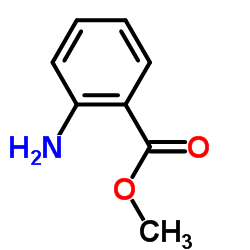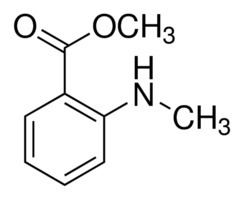Formula C8H9NO2 Boiling point 256 °C | Melting point 24 °C | |
How to make grape flavoring methyl anthranilate
Methyl anthranilate, also known as MA, methyl 2-aminobenzoate, or carbomethoxyaniline, is an ester of anthranilic acid. Its chemical formula is C8H9NO2.
Contents
- How to make grape flavoring methyl anthranilate
- Informational rejex it video
- Chemical properties
- Uses
- Occurrence
- References

Informational rejex it video
Chemical properties

It is a clear to pale yellow liquid with melting point 24 °C and boiling point 256 °C. It has a density of 1.168 g/cm3 at 20 °C. It has a refractive index of 1.583 at 589 nm of wavelength and 20 °C. It shows a light blue fluorescence. It is very slightly soluble in water, and soluble in ethanol and propylene glycol. It is insoluble in paraffin oil. It is combustible, with flash point at 104 °C. At full concentration, it has a fruity grape smell; at 25 ppm it has a sweet, fruity, Concord grape-like smell with a musty and berry nuance.
Uses

Methyl anthranilate acts as a bird repellent. It is food-grade and can be used to protect corn, sunflowers, rice, fruit, and golf courses. Dimethyl anthranilate (DMA) has a similar effect. It is also used for the flavor of grape Kool-Aid. It is used for flavoring of candy, soft drinks , e.g. grape soda, chewing gum, drugs, and nicotine products.

Methyl anthranilate both as a component of various natural essential oils and as a synthesised aroma-chemical is used extensively in modern perfumery. It is also used to produce Schiff bases with aldehydes, many of which are also used in perfumery. In a perfumery context the most common Schiff's Base is known as aurantiol, produced by combining methyl anthranilate and hydroxycitronellal.
Occurrence
Methyl anthranilate naturally occurs in the Concord grapes and other Vitis labrusca grapes and hybrids thereof, and in bergamot, black locust, champak, gardenia, jasmine, lemon, mandarin orange, neroli, oranges, rue oil, strawberry, tuberose, wisteria, galangal, and ylang ylang. It is also a primary component of the essential apple flavor, along with ethyl acetate and ethyl butyrate.
